New Find Links the Sutton Hoo Helmet to Denmark
A stamp found with a metal detector on the Danish island of Tåsinge indicates that the iconic helmet from Sutton Hoo in England could have been made in the South Funen archipelago. The find could change what we know about the power balance in Northern Europe in the 7th century, with Denmark playing a more central role than previously thought.
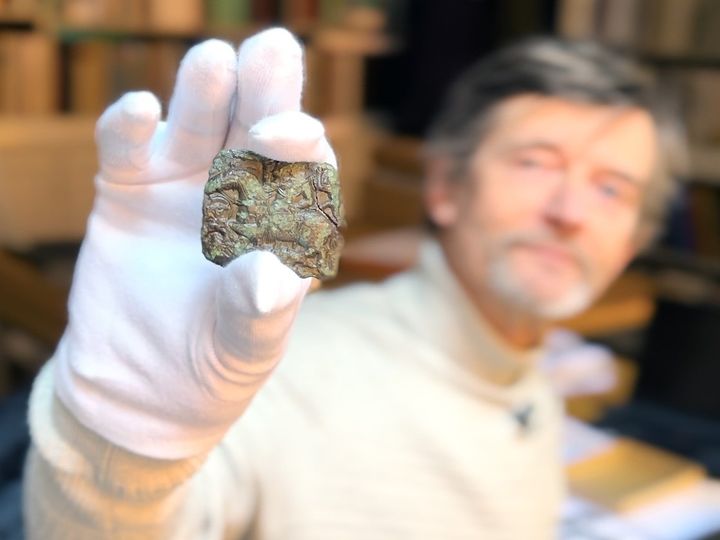
The iconic Sutton Hoo helmet is one of Great Britain’s most iconic finds, often referred to as the ‘British Tutankhamen’. It was previously believed to come from Uppland in Sweden, where helmets decorated with mounted warriors like one of the motifs on the helmet have been found.
But the new detector find in Tåsinge bears a striking resemblance to one of the motifs on the helmet from Sutton Hoo, which could change our understanding of the origins of the helmet and the power balance in Northen Europe around 600 CE.
The helmet was buried in Southeast England at beginning of the 7th century as part of an elaborate ship burial worthy of a king. It did not see the light of day again until it was discovered during an archaeological excavation in the area in 1939.
The helmet was in hundreds of pieces, but experts were able to reassemble the fragments, including the motif of a mounted warrior with a man lying under the horse.
The same motif has now been traced to Tåsinge in the Southern Funen archipelago, where a special kind of stamp known as a ‘patrice’ has been found by a detectorist. A thin sheet of metal is placed on top of the patrice then hammered to create the same motif on the metal. The stamp was handed in at Svendborg Museum then sent to the National Museum of Denmark where museum curator Peter Pentz has studied it in detail.
Comparing the motif on the newly discovered patrice from Tåsinge to the mounted warrior on the Sutton Hoo helmet and those from Sweden, it is clear that the Tåsinge patrice is much closer to the one on the helmet than the Swedish motifs.
Similarities can be seen in the details, such as the cuff at the warrior’s wrist, the warrior’s hair, the almondshaped harness fitting on the horse’s head, its reins, the sword protruding below the warrior’s shield, and the ‘bunions’ or circles on the feet of the man lying down. The Swedish equivalents have a wild boar or bird of prey on the helmet, something not seen the Sutton Hoo helmet or the new find from Tåsinge.
According to Peter Pentz, curator at the National Museum of Denmark, this could mean the famous helmet is more likely to have been made in Denmark than Sweden:
“The Sutton Hoo helmet is iconic worldwide. It is a national treasure for the British on a par with the chariot of the sun for Danes. It would be sensational if this helmet, obviously worn by someone of great importance, possibly a king, was made in Tåsinge. It points to a possible Danish connection to the helmet, but also to the person who wore and was buried with it.”
Another Possibly Identical Motif
The connection between Tåsinge and Sutton Hoo could turn out to be even stronger. In addition to the first motif of a mounted warrior, there is another mounted warrior on the helmet. Here, however, only a few fragments have been found, so it has not been able to reassemble it in full.
Close examination of the details on these fragments, however, reveals an even stronger match with the Tåsinge motif than the fully reassembled motif on the Sutton Hoo helmet. According to Peter Pentz, two details are particularly striking.
The first is the lines by the horseman’s foot, which are the same on the stamp and fragment, but absent from other motifs. The second is the edge of the shield of the man lying down, which is the same on the stamp and the fragment.
The striking similarity between the fragmented motif and the patrice could mean that they might not only come from the same area but were also made by the same group of craftsmen. As Peter Pentz says:
“Despite being made in very different places, many motifs are clearly inspired by each other. But when the likeness is as strong as it is here, it could mean that they were not only made in the same place but even by the same craftsmen. That could provide strong evidence that the Sutton Hoo helmet was actually made in Tåsinge, which would make it an incredible find.”
Exactly how close the two are can hopefully be established by a planned 3D scan of the patrice and fragments.
Was Denmark a Regional Superpower?
If the Sutton Hoo helmet was actually made in or around Tåsinge this would change former understandings of the role Denmark played in the power balance in Northern Europe around the year 600.
No traces of the magnificent burial sites discovered in England and Sweden from this period have been found in Denmark, which has led some to conclude that the Danish region played no significant role.
According to Peter Pentz, however, the new find establishes a much stronger basis for thinking Denmark was relatively powerful during this period, maybe even one of Northern Europe’s leading powers.
Some experts have previously argued that England and Sweden could have been outposts of a Danish power base in the 7th century, and that the iconic helmets and ship burials found here can be seen as expressing a strong affiliation to Denmark as a central power.
This theory is strengthened by the find in Tåsinge, but it cannot stand alone. As Peter Pentz adds, a small stamp that is only 4.5 cm wide could have travelled far and wide.
“It is still too early to draw any conclusions, but it does indicate that Denmark played a more important role during this period than previously assumed. We often attribute the uniting of the kingdom to Harald Bluetooth in the 10th century, but Denmark could have been relatively united and powerful as early as 600 CE. It is a find that challenges previous theories, and that is always exciting,” says Peter Pentz.
The stamp will be exhibited at the National Museum of Denmark from Tuesday, April 1.
Nøgleord
Kontakter
John Fhær Engedal NissenCommunications OfficerThe National Museum of Denmark
Tlf:+45 4120 6849jni@natmus.dkPeter PentzCuratorThe National Museum of Denmark
Tlf:+45 4120 6152peter.pentz@natmus.dkBilleder
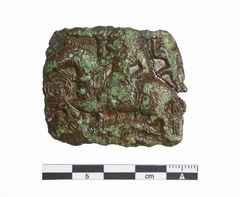
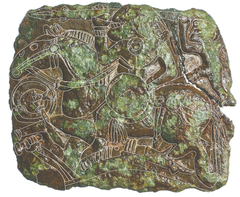
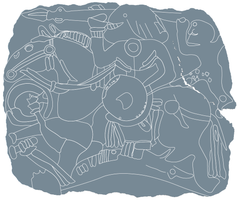
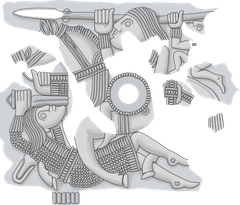
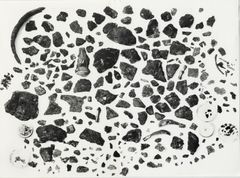
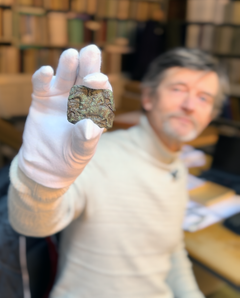
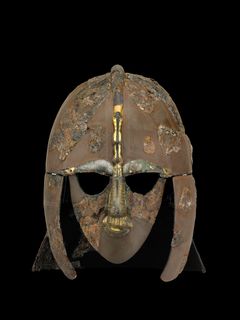
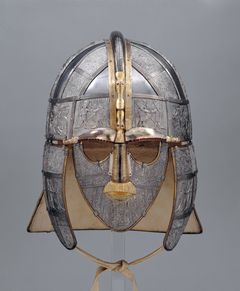


Nationalmuseet
Nationalmuseet er Danmarks kulturhistoriske hovedmuseum. Det ligger i Prinsens Palæ i København, hvor det har haft adresse siden 1849.
Nationalmuseet består foruden af besøgsstedet i København også af en forsknings-, samlings og bevaringsafdeling, der tager sig af konservering og bevaring af Danmarks kulturskatte samt forskning i både kulturhistoriske og naturvidenskabelige emner.
Der er 18 besøgssteder knyttet til Nationalmuseets organisation, som Rane Willerslev er direktør for.
Følg pressemeddelelser fra Nationalmuseet – Forskning og Kulturarv
Skriv dig op her, og modtag pressemeddelelser på e-mail. Indtast din e-mail, klik på abonner, og følg instruktionerne i den udsendte e-mail.
Flere pressemeddelelser fra Nationalmuseet – Forskning og Kulturarv
Nyt studie: Klimaskabt tørke nedbryder fortidsminder på rekordtid27.11.2025 08:42:00 CET | Pressemeddelelse
Et nyligt publiceret studie viser, hvor hurtigt udtørring nedbryder arkæologiske fund i danske moser. Genstande af træ kan ligge bevaret i moser i flere tusinde af år, men når tørken rammer, kan de blive ødelagt på 2-3 måneder.
Ida Nicolaisen modtager Nationalmuseets jubilæumsmedalje29.9.2025 11:38:49 CEST | Pressemeddelelse
Efter en livslang indsats indenfor forskning modtager antropolog Ida Nicolaisen Nationalmuseets æresmedalje. Overrækkelsen fandt sted til Forskningens Aften.
H.M. Dronning Mary deltager i Forskningens Aften på Nationalmuseet11.9.2025 15:18:35 CEST | Pressemeddelelse
Når Nationalmuseet præsenterer sin nyeste og mest banebrydende forskning i et eksklusivt arrangement den 24. september, bliver det med deltagelse af H. M. Dronningen.
The National Museum discovers new details regarding Viking hairstyles27.8.2025 06:05:00 CEST | Press release
A small, unique gaming piece from the Viking Age reveals a hairstyle that was probably in vogue among Vikings at the time of Harald Bluetooth. This is as close as we get to a portrait of a Viking, says scholar.
Nationalmuseet opdager nye detaljer i vikingernes frisure27.8.2025 06:00:00 CEST | Pressemeddelelse
En lille, unik spillebrik fra vikingetiden afslører, hvilken frisure der formentlig var på mode blandt vikingerne på Harald Blåtands tid. Det tætteste vi kommer på et vikingeportræt, mener forsker.
I vores nyhedsrum kan du læse alle vores pressemeddelelser, tilgå materiale i form af billeder og dokumenter samt finde vores kontaktoplysninger.
Besøg vores nyhedsrum